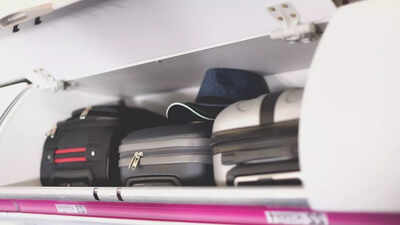ARTICLE AD BOX

Flying comes with strict security regulations to ensure passenger safety. The Bureau of Civil Aviation Security (BCAS) and ICAO set clear guidelines on items prohibited in cabin baggage to prevent potential threats.
Carrying restricted or dangerous goods such as sharp objects, flammable materials, and chemicals can lead to confiscation, heavy fines, or even denial of boarding.
Since cabin baggage is kept inside the aircraft, these items pose a serious risk in a pressurised environment and could endanger passengers and crew. Understanding these rules and packing accordingly ensures a hassle-free travel experience and compliance with aviation security standards.
Cabin baggage rules: What NOT to carry on a flight
To help you travel stress-free, here’s the updated list of 12 prohibited items you must never pack in your hand baggage.1. Firearms, ammunition, and replica weaponsAny type of firearm or imitation weapon is strictly banned from the aircraft cabin for obvious security reasons. Even non-functional or replica weapons can cause panic and lead to delays or legal action. If you need to carry a licensed firearm, it must be declared and transported in checked baggage under strict regulations.
Examples include:
- Pistols, rifles, and shotguns
- Ammunition (bullets, cartridges)
- Toy guns and realistic replicas
- Firearm parts or accessories
2. Explosives and pyrotechnic materialsExplosives, fireworks, and related materials are completely prohibited because they can ignite or explode in the pressurised aircraft environment. These items pose severe safety threats to everyone onboard, so they should never be included in your cabin or checked luggage.Prohibited examples:
- Fireworks, crackers, sparklers
- Detonators, blasting caps, and grenades
- Signal flares and smoke bombs
3. Sharp and pointed objectsObjects with sharp edges can easily be used as weapons, making them a major security concern.
Even everyday items like scissors or nail cutters are restricted if they have sharp blades. If essential, these items should be packed in your checked baggage instead.Includes:
- Knives of any type or size
- Razor blades and box cutters
- Scissors (including cosmetic scissors)
- Swords, daggers, or similar items
4. Blunt instruments and sporting equipmentBlunt or heavy objects can cause injury or be misused during a flight. Sporting goods like cricket bats or hockey sticks might seem harmless but are considered potential weapons in the confined space of an aircraft.
Always send such items in your checked baggage.Examples:
- Baseball bats, cricket bats, golf clubs
- Martial arts gear like nunchakus or batons
- Dumbbells, weights, and heavy gym equipment
5. Flammable liquids and solidsFlammable substances are one of the biggest hazards on board as they can ignite due to heat or pressure changes during flight. These items are banned from both cabin and checked luggage to minimise fire risk.Banned substances:
- Petrol, diesel, kerosene
- Lighter fuel or refills
- Camping fuel, fire starters
- Paints, varnishes, and adhesives
6. Chemical and toxic substancesToxic chemicals and corrosive substances can leak, react with other materials, or release dangerous fumes.
They pose severe health hazards to passengers and crew if brought inside the aircraft cabin.Do NOT pack:
- Acids, alkalis, or corrosives
- Insecticides, pesticides, weed killers
- Radioactive materials
- Wet cell batteries
7. Compressed gasesGas cylinders, whether filled or empty, are considered dangerous goods because of the risk of explosion or leakage in a pressurised cabin. These items are not allowed in either hand baggage or checked baggage without special clearance.Examples include:
- Oxygen cylinders
- Butane or propane gas canisters
- Spray paints or aerosol cleaning products
8. Self-defence itemsWhile self-defence devices may seem necessary for personal safety, they can be misused on board and pose a security threat.
Airlines do not permit these items in cabin luggage to prevent any possibility of harm.Prohibited items:
- Pepper spray or mace
- Stun guns or tasers
- Knuckle dusters or batons
9. Liquids, gels, and aerosols over 100 mlThere is a strict restriction on carrying liquids in hand baggage to prevent the risk of harmful chemicals being disguised as everyday items. The 100 ml rule applies to all liquid-based products, and they must be packed in a clear, resealable plastic bag. Items include shampoos, toothpaste, creams, perfumes, and beverages10. Large electronic devices with high-power batteriesElectronic devices are generally allowed, but high-capacity lithium batteries can overheat and catch fire.
Devices that cannot be switched off during the flight also pose operational risks, so always check the airline's battery watt-hour (Wh) limit before travelling.Restrictions include:
- Power banks over 160 Wh
- Large lithium-ion battery packs
- Devices that cannot be powered off
11. Tools and heavy metal objectsTools can easily be used as blunt weapons and therefore are prohibited in the cabin. Even small tools like screwdrivers or wrenches can pose security risks and must be placed in checked baggage.Includes:
- Hammers, drills, and screwdrivers
- Wrenches, pliers, or crowbars
- Saw blades and cutting tools
12. Infectious or biological materialsBiological materials can spread infections and are classified as dangerous goods.
Transporting these without proper authorisation is a serious violation of aviation safety rules.Examples:
- Medical specimens
- Infectious substances
- Live bacteria cultures
These restrictions exist to protect passengers, crew, and the aircraft from threats like fire, explosions, and physical harm. Carrying prohibited items can lead to fines, legal action, or even cancellation of your flight. Always review the latest BCAS guidelines and your airline's baggage policy before you travel.



.png)
.png)
.png)
















 7 hours ago
3
7 hours ago
3








 English (US) ·
English (US) ·